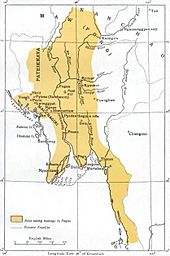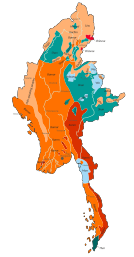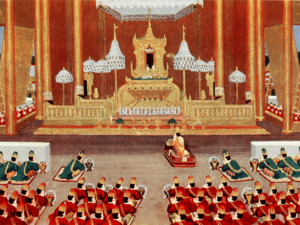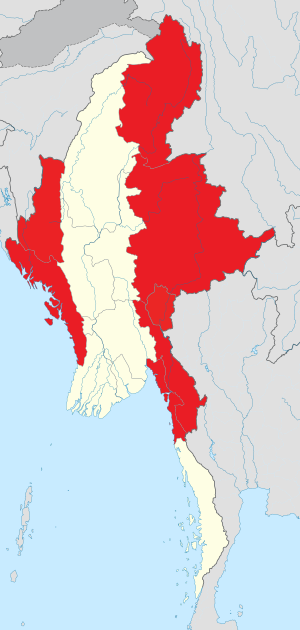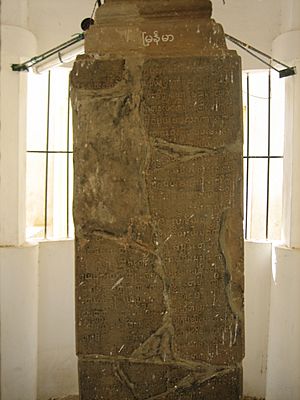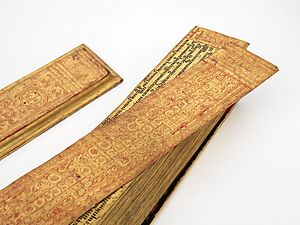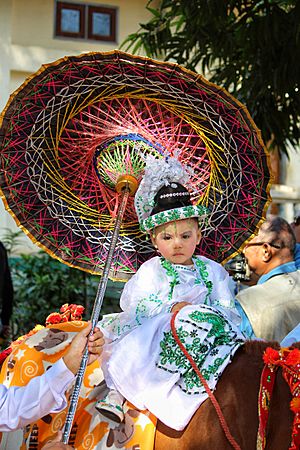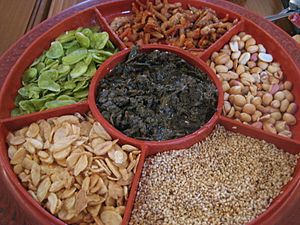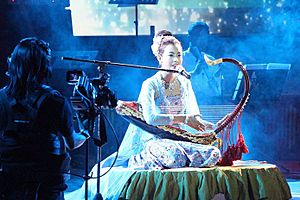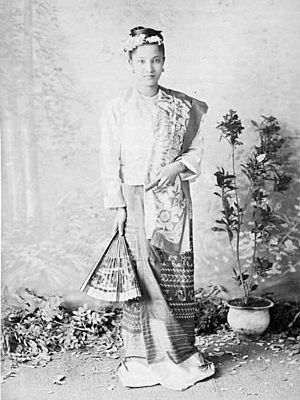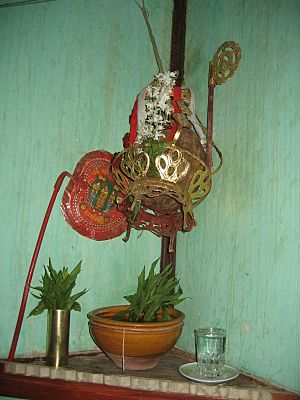Bamar people facts for kids
| ဗမာလူမျိုး | |
|---|---|
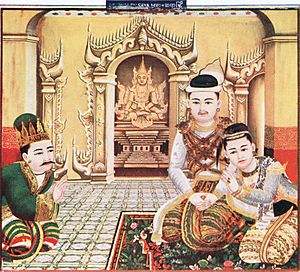
A 1912 painting depicts members of the Bamar court in royal attire paying homage to the Mahamuni Buddha
|
|
| Regions with significant populations | |
| 28,860 | |
| 32,655 | |
| 50,000 | |
| 2,300,000 | |
| Languages | |
| Burmese | |
| Religion | |
| Predominantly Theravada Buddhism and Burmese folk religion Minority Christianity and Islam |
|
| Related ethnic groups | |
|
|
The Bamar (also known as the Mranma) are a large group of people living in Myanmar, a country in Southeast Asia. They are the biggest ethnic group in Myanmar, making up about 68% of the country's population. This means there are around 35 million Bamar people. Their homeland is mainly around the Irrawaddy River basin. The Burmese language is their native language. It is also the official language of Myanmar and is used by most people across the country.
Contents
Understanding the Names: Bamar and Myanmar
In the Burmese language, the words Bamar and Myanmar have been used to mean the same thing for a long time. They both refer to the country and its main ethnic group. "Bamar" is often used in everyday talk, while "Myanmar" is more formal.
The word "Myanmar" has been around since the 1100s. It was used to describe the culture of the people. When the British ruled Burma, "Bamar" was used for both the country and its people. After Myanmar became independent in 1948, "Myanmar" became the official name for the country and its language. "Bamar" then became the official name for the main ethnic group, especially in writing. However, in daily conversations, people still use "Bamar" and "Myanmar" interchangeably for the language and country.
In English, the Bamar people were often called "Burmans" or "Burmese." In 1989, the government changed the official English names. They changed the country's name from Burma to Myanmar. The language changed from Burmese to Myanmar, and the ethnic group from Burmans to Bamar. This was done to use names closer to the local language.
Where the Bamar People Came From
The Bamar people originally came from areas north of Myanmar. This is shown by where similar languages are spoken today. The Burmese word for 'south' also means 'mountain.' This suggests that their ancestors once lived north of the Himalayas. A thousand years ago, the ancestors of the Bamar and Yi lived in many parts of China and northern Burma.
Between the 600s and 800s, many Bamar ancestors moved south. They traveled along the Irrawaddy River and Salween River. They set up a settlement called Pagan. They slowly settled in the rich river valleys. These valleys were already home to Pyu city-states. The Bamar then established the Pagan Kingdom.
Around 1050 to 1060, King Anawrahta founded the Pagan Empire. This was the first time the Irrawaddy valley was united under one ruler. By the 1100s, the Burmese language and culture became very important in the upper Irrawaddy valley. It became more dominant than the Pyu and Pali cultures. Old Burmese stories say that the Pyu people became part of the Bamar population.
By the 1200s, Bamar settlements reached as far south as Mergui and Tenasserim. People there still speak old Burmese dialects. Starting in the 900s, Burmese speakers also moved west. They crossed the Arakan Mountains and settled in what is now Rakhine State. By the 1100s, they controlled this area. They became a part of the Pagan Empire until the 13th century. Over time, these Bamar migrants developed their own culture. They became known as the Rakhine people.
What DNA Tells Us
A DNA study in 2014 found that the Bamar have a lot of different genetic backgrounds. This suggests that as the Bamar expanded after the 800s, they likely mixed with older groups like the Pyu and Mon people. Another study looked at genes in Mon and Bamar men. It found that these two groups probably share common ancestors. This is interesting because they speak different language families. A 2022 study also found that people in Central and Southern Thailand have some Bamar ancestry.
Who Are the Bamar Today?
Today, being Bamar often means speaking the Burmese language and practicing Theravada Buddhism. However, people who identify as Bamar can be very different from each other. Members of other ethnic groups, like the Mon, Shan, Karen, and Sino-Burmese, sometimes also identify as Bamar. Some even fully become part of the Bamar culture.
The Burmese language does not have exact words to separate ideas like race, ethnicity, and religion. The term lu-myo (လူမျိုး) can mean all three. For example, many Bamar people say they are part of the 'Buddhist lu-myo or the '[[Burmese people|Myanmar lu-myo. This has made it hard for people counting the population in surveys.
Before British rule, ethnic identity was flexible. People often changed their identity based on their relationships, religion, and where they lived. Many non-Bamar people became Bamar and adopted their customs for social or political reasons. Between the 1500s and 1800s, the idea of being Bamar grew a lot. This happened because of marriages with other groups and people choosing to identify as Bamar. This was especially true in areas where Mon and Shan languages were spoken.
In the early 1900s, a stronger sense of Bamar nationalism grew. This was a reaction to British colonial rule. The British did not address the Bamar's complaints. They also kept the Bamar out of public life, like education and the army. The British used a "divide and rule" strategy. This created distrust between the Bamar and other ethnic groups. This had a big impact on Myanmar's ethnic identity and politics after independence. In 1925, the British removed all Bamar soldiers from the colonial army. They only recruited from the Chin, Kachin, and Karen minority groups. By 1930, a leading Burmese nationalist group called the Dobama Asiayone appeared. Future independence leaders like U Nu and Aung San started their political careers there.
How the Government Classifies Groups
The Myanmar government officially lists nine "ethnic groups" under the Bamar "national race." Some of these groups, like the Dawei, Myeik, Yaw, and Yabein, speak dialects of the Burmese language. One group, the Hpon, speaks a language closely related to Burmese. Two groups, the Kadu and Ganan, speak more distantly related languages. The last group, the Moken, speaks a completely different language. Interestingly, the Burmese-speaking Danu and Intha are classified under the Shan "national race."
Where Bamar People Live
In Myanmar
Most Bamar people live in the central part of Myanmar. This area includes the valleys of the Irrawaddy River, Salween River, and Sittaung River. These areas roughly cover Myanmar's seven administrative regions. These are Sagaing, Magwe, Mandalay in Upper Myanmar. They also include Bago, Yangon, Ayeyarwady, and Taninthayi Regions in Lower Myanmar. However, Bamar people, especially those who move for work, can be found in all of Myanmar's 14 regions and states.
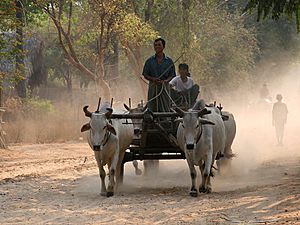
The main cultural area for the Bamar is called Anya (အညာ). This means 'upstream.' It is the area along the upper Irrawaddy River, centered around Sagaing, Magwe, and Mandalay. The Anya region is often called the 'central dry zone' in English. This is because it does not get much rain and relies on irrigation. For 1,100 years, this region was home to many Burmese royal capitals. This lasted until the British took over Upper Burma in 1885. Bamar people from this region are called anyar thar (အညာသား).
In the 1500s, the Bamar began to settle in the lower parts of the Irrawaddy River valley. This included Taungoo and Prome. This helped spread the Burmese language and Bamar customs. This movement of people increased during the Konbaung dynasty. It was especially common for men who were good at growing rice. After the British took over Lower Burma in 1852, millions of Bamar from the Anya region moved to the Irrawaddy Delta. This happened between 1858 and 1941. The British encouraged Bamar farmers to move there. They wanted to grow more rice in the colony.
Bamar People Around the World
Bamar people have also moved to other countries. This is similar to how many people from Myanmar have moved abroad. Many started leaving during World War II. They continued to leave because of military rule, economic problems, and political instability. Many have settled in Europe, especially in Great Britain. After Myanmar became independent in 1948, many Bamar moved to Asian countries. These include Thailand, Malaysia, Singapore, China, and Japan. They also moved to English-speaking countries like the United States, United Kingdom, Australia, and New Zealand.
The Burmese Language
Burmese is the native language of the Bamar people. It is also the national language of Myanmar. Burmese is part of the Sino-Tibetan language family. It is the most widely spoken Tibeto-Burman language. About 97% of Myanmar's population uses it to communicate.
Burmese has two main forms: a formal written form and a spoken form. The written form keeps many old words and grammar rules from Old Burmese stone writings. These are no longer used in spoken Burmese.
Pali, the language of Theravada Buddhism, is a major source of words borrowed into Burmese. British rule also brought many English words into the Burmese language. As a language used by many different groups, Burmese has also given and received words from other languages in the region.
The Burmese language has a long history of writing and reading. It was the fifth Sino-Tibetan language to develop a writing system. The oldest surviving written Burmese document is the Myazedi inscription, from 1113. The Burmese script comes from an Indic writing system. Modern Burmese spelling still has features from Old Burmese. The Shan, Ahom, Khamti, Karen, and Palaung scripts are all based on the Burmese script.
Standard Burmese is based on the language spoken in the cities of Yangon and Mandalay. However, there are also distinct Burmese dialects. These include Yaw, Dawei, Myeik, Palaw, Intha-Danu, Arakanese (Rakhine), and Taungyo. These dialects are found in more distant areas of the country. They differ from Standard Burmese in how words are pronounced and which words are chosen, but not in grammar. For example, Arakanese keeps a certain 'r' sound. This sound changed to a 'y' sound in standard Burmese between the 1700s and 1800s.
Bamar Culture and Society
Bamar culture includes traditions, literature, food, music, dance, and theater. It has been greatly shaped by Theravada Buddhism. It has also been influenced by contact with neighboring societies. More recently, Myanmar's colonial and post-colonial history has also played a role.
A key Bamar value is anade. This means being very careful not to offend someone or make them feel embarrassed. Charity and giving to others are also very important in Bamar society. Myanmar is often ranked among the world's most generous countries.
The Bamar people traditionally recognize Twelve Auspicious Rites. These are a series of important life events. The most common ones today are naming a child, the first feeding, ear-piercing for girls, Buddhist ordination (shinbyu) for boys, and wedding rites.
Calendar and Festivals
The traditional Burmese calendar is based on the sun and moon. It was used throughout mainland Southeast Asia until the late 1800s. Like in Thailand, Laos, and Cambodia, Thingyan marks the start of the Burmese New Year. This happens in April. Several Buddhist full moon days are national holidays. These include the full moon days of Tabaung, Kason, Waso, Thadingyut, and Tazaungmon. Full moon days often coincide with many pagoda festivals. These festivals usually celebrate events in a pagoda's history.
Delicious Bamar Food
White rice is the main food for the Bamar. This shows that rice has been grown in Burmese-speaking areas for a thousand years. Burmese curries are made with onions, garlic, ginger, paprika, and turmeric. They are usually eaten with rice, along with Burmese salads, soup, cooked vegetables, and ngapi (fermented shrimp or fish paste). Noodles and Indian breads are also eaten. Bamar food varies by region. This is because different ingredients are available locally. Upper Burmese food uses more land meats like pork and chicken, and beans. Lower Burmese food uses more seafood and fish products like ngapi.
The Bamar traditionally drink green tea. They also eat pickled tea leaves, called lahpet. This plays an important role in their culture. Burmese food is also known for its many sweet and savory snacks, called mont. The most famous Bamar dish is mohinga. This is rice noodles in a fish broth. It is considered the national dish of Myanmar.

Burmese food has been greatly influenced by contact with neighboring kingdoms and countries. The exchange of goods in the 15th and 16th centuries brought new ingredients. These included tomatoes, chili peppers, peanuts, and potatoes. Food has always been connected to Bamar religious life. This is seen in giving food to monks (dāna) and community feasts.
Bamar Literature and Music
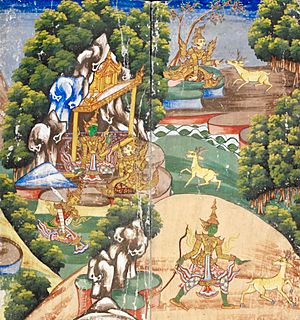
Burmese literature has a long history. It includes both religious and everyday stories. Old Burmese stories and historical writings are the basis of the Bamar's historical writing traditions.
Traditional Bamar music has folk and classical styles. Folk music often uses the hsaing waing. This is a musical group with gongs, drums, and other instruments. The pat waing, a drum circle, is the main part of this group. Classical music comes from Burmese royal court traditions. The Mahāgīta is the collection of all Burmese classical music. It is often played with a small group of instruments. These include a harp called saung gauk, bells, and a xylophone called pattala.
Traditional Dress and Appearance
- Further information: Burmese clothing
The Bamar traditionally wear longyi. This is an ankle-length skirt that is wrapped around the waist. The modern longyi became popular during British colonial times. It replaced the longer paso (for men) and htamein (for women) from earlier times. The local acheik silk fabric is known for its colorful wave-like patterns. It is strongly linked to the Bamar.
Formal clothes for men include a longyi with a jacket called taikpon (တိုက်ပုံ). They also wear a cloth turban called gaung baung (ခေါင်းပေါင်း). Velvet sandals called gadiba phanat (ကတ္တီပါဖိနပ်) are worn for formal occasions by both men and women.
Bamar people of all ages and genders also put thanakha on their skin. This is a paste made from the wood of certain trees. It is especially used on their faces. Today, mostly women, children, and young, unmarried men use it. Many other ethnic groups in Myanmar also use thanakha. Western makeup is also popular in cities.
Bamar Personal Names
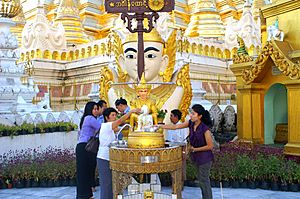
Bamar people usually have only one personal name. They do not have family names or surnames. Burmese names often combine native and Pali words. These words symbolize good qualities. Female names often mean beauty, flowers, and family values. Male names often mean strength, bravery, and success.
People add honorifics (titles) to names based on gender, age, and social status. For example, a Bamar male might be called "Maung" when young. He then becomes "Ko" as a middle-aged adult, and "U" when he gets older.
A common Bamar naming custom uses the child's day of birth to decide the first letter of their name. This shows how important the day of birth is in Burmese astrology. The traditional Burmese calendar includes Yahu, which is Wednesday afternoon.
| Day of birth | Letters |
|---|---|
| Monday (တနင်္လာ) |
က (ka), ခ (kha), ဂ (ga), ဃ (gha), င (nga) |
| Tuesday (အင်္ဂါ) |
စ (sa), ဆ (hsa), ဇ (za), ဈ (za), ည (nya) |
| Wednesday (ဗုဒ္ဓဟူး) |
လ (la), ဝ (wa) |
| Yahu (ရာဟု) |
ယ (ya), ရ (ya, ra) |
| Thursday (ကြာသပတေး) |
ပ (pa), ဖ (hpa), ဗ (ba), ဘ (ba), မ (ma) |
| Friday (သောကြာ) |
သ (tha), ဟ (ha) |
| Saturday (စနေ) |
တ (ta), ထ (hta), ဒ (da), ဓ (da), န (na) |
| Sunday (တနင်္ဂနွေ) |
အ (a) |
Religion and Beliefs
- Further information: Buddhism in Myanmar and Burmese folk religion

Most Bamar people follow a mix of Theravada Buddhism and local Burmese folk religion. The folk religion involves respecting spirits called nat. This belief existed before Buddhism came to Myanmar. Both faiths are very important in Bamar cultural life.
Theravada Buddhism is closely tied to Bamar identity. It has been the main faith among Burmese speakers since the 11th century. This was during the Pagan dynasty. Today, Bamar Buddhists usually follow basic five precepts. They also practice dāna (charity), sīla (Buddhist ethics), and bhavana (meditation). Village life often centers around Buddhist monasteries called kyaung. These serve as community centers and meet spiritual needs. Buddhist Sabbath days, called Uposatha, are observed by more devoted Buddhists.
Some older Buddhist beliefs are still popular among the Bamar. This includes respecting Shin Upagutta, Shin Thiwali, and Lawkanat. The influence of Hinduism can be seen in the respect for Hindu gods like Thuyathadi and the practice of yadaya rituals.
The Bamar also believe in guardian nats. They especially respect Mahagiri, the household guardian nat. Bamar homes traditionally have a shrine. This shrine holds a long-stemmed coconut called on-daw (အုန်းတော်). This coconut symbolizes Mahagiri. The shrine is usually placed at the main southwest pillar of the house.
The way Burmese folk religion is practiced can vary by location. Bamar people in Upper Myanmar and cities tend to honor the Thirty-Seven Min. This is a group of nats linked to the old royal court. Meanwhile, Bamar people in Lower Myanmar often honor other local or guardian nats like Bago Medaw and U Shin Gyi. Small Spirit houses called nat ein (နတ်အိမ်) or nat sin (နတ်စင်) are common in Bamar areas.
A small number of Bamar people practice other religions. These include Islam and Christianity. Among them, Bamar Muslims are descendants of marriages between Indian Muslim fathers and Bamar Buddhist mothers. They identify themselves as Bamar.
See also
 In Spanish: Birmania para niños
In Spanish: Birmania para niños
- Burmese pagoda & Pagoda festival
- Shinbyu & Awgatha
- Burmese people
- Culture of Myanmar
- Demographics of Myanmar
- Danu people
- Rakhine people
- Burmese mythology


